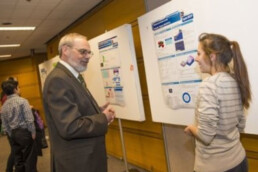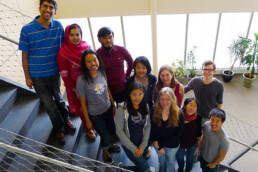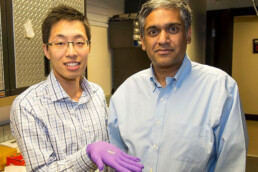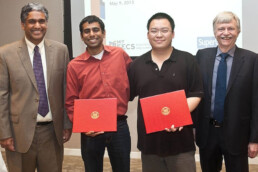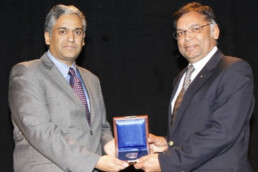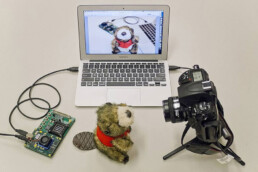Industry finds ‘top-notch engineering students’ in SuperUROP
On Dec. 5, Paul Bassett ’85 traveled to Cambridge from Austin, Tex., where he works as a senior director of technology for the wireless communications giant Qualcomm. He wound his way through a crowd assembled in the Grier Room at MIT, where nearly 80 undergraduates in electrical engineering and computer science (EECS) presented posters on cutting-edge research projects. Qualcomm sponsors several of those students as part of the MIT SuperUROP program.
Under the leadership of EECS department head Anantha P. Chandrakasan, the Joseph F. and Nancy P. Keithley Professor of Electrical Engineering, and MIT’s Undergraduate Research Opportunities Program, SuperUROP launched last year as a way to offer undergraduates a deep dive into research.
SuperUROP raises bar for undergraduate research and innovation
EECS September kickoff reception features guest speakers Susan Hockfield and Ray Stata
The MIT Department of Electrical Engineering and Computer Science (EECS) held a kickoff reception at the Stata Center on Sept. 26 for 80 of its juniors and seniors who recently started their yearlong participation in the Advanced Undergraduate Research Opportunities Program (or SuperUROP).
Speakers at the reception praised SuperUROP, now in its second year, for continuing to raise the bar at MIT for undergraduate research and innovation, while fostering collaboration between faculty and industry.
MIT’s EECS department embraces student leadership
When Anantha Chandrakasan, the Joseph F. and Nancy P. Keithley Professor of Electrical Engineering, took the helm of MIT’s Department of Electrical Engineering and Computer Science (EECS) in 2011, he quickly set two big ideas into motion. One was to make the Undergraduate Research Opportunities Program (UROP) more appealing to EECS majors. The goal was to offer Course 6 undergraduates more research options within the department, as well as chances to work on longer-term, sustained projects.
The other was to form the Undergraduate Student Advisory Group in EECS (USAGE) to help him understand the student perspective. This group provided pivotal feedback that helped guide decisions about UROPs. Giving the students a stronger voice has transformed the department into more than a place where students come to learn about devices, signals, theory and systems: Course 6 is also a place where students become leaders.
Detecting early-stage malarial infection
New prototype device recognizes electrical properties of infected cells as signatures of disease.
Researchers at MIT have found a way to detect early-stage malarial infection of blood cells by measuring changes in the infected cells’ electrical properties.
The scientists, from the laboratories of MIT’s Anantha Chandrakasan and Subra Suresh — who is now president of Carnegie Mellon University — have built an experimental microfluidic device that takes a drop of blood and streams it across an electrode that measures a signal differentiating infected cells from uninfected cells. The work, published Aug. 8 in the journal Lab on a Chip, is a first step toward a field-ready, low-cost, portable malaria-detection device.
First ‘SuperUROPs’ cap off inaugural year
EECS program immerses undergraduates in advanced research projects.
How can crowdsourcing help plan your next vacation? How good are government officials at living up to their promises? And who among the millions of students taking online courses are likeliest to drop out?
These are all questions researchers are tackling in MIT’s Department of Electrical Engineering and Computer Science (EECS). But the researchers heading up these projects aren’t faculty members or graduate students — they’re undergraduates who are making discoveries in fields like web security, bioinformatics and motion planning while balancing problem sets, campus activities and, for many seniors, job interviews.
MIT researchers build Quad HD TV chip
It took only a few years for high-definition televisions to make the transition from high-priced novelty to ubiquitous commodity — and they now seem to be heading for obsolescence just as quickly. At the Consumer Electronics Show (CES) in January, several manufacturers debuted new ultrahigh-definition, or UHD, models (also known as 4K or Quad HD) with four times the resolution of today’s HD TVs.
In addition to screens with four times the pixels, however, UHD also requires a new video-coding standard, known as high-efficiency video coding, or HEVC. Also at CES, Broadcom announced the first commercial HEVC chip, which it said will go into volume production in mid-2014.
Chandrakasan honored at ISSCC’s 60th Plenary Session
Anantha P. Chandrakasan earns prestigious award for outstanding contributions to his field.
Anantha P. Chandrakasan, the Joseph F. and Nancy P. Keithley Professor of Electrical Engineering at MIT, was honored with a prestigious award at the 60th annual IEEE International Solid-State Circuits Conference (ISSCC), held in San Francisco from Feb. 17-21.
In presenting Chandrakasan with the 2013 IEEE Donald O. Pederson Award in Solid-State Circuits, the IEEE recognized Chandrakasan for his outstanding contributions to the field of semiconductor circuits in terms of benefitting society, enhancing technology and demonstrating professional leadership. Chandrakasan, who also heads up MIT’s Department of Electrical Engineering and Computer Science, has been conference chair of ISSCC since 2010.
Picture-perfect
Quick, efficient chip cleans up common flaws in amateur photographs.
Your smartphone snapshots could be instantly converted into professional-looking photographs with just the touch of a button, thanks to a processor chip developed at MIT.
The chip, built by a team at MIT’s Microsystems Technology Laboratory, can perform tasks such as creating more realistic or enhanced lighting in a shot without destroying the scene’s ambience, in just a fraction of a second. The technology could be integrated with any smartphone, tablet computer or digital camera.
Existing computational photography systems tend to be software applications that are installed onto cameras and smartphones. However, such systems consume substantial power, take a considerable amount of time to run, and require a fair amount of knowledge on the part of the user, says the paper’s lead author, Rahul Rithe, a graduate student in MIT’s Department of Electrical Engineering and Computer Science.
